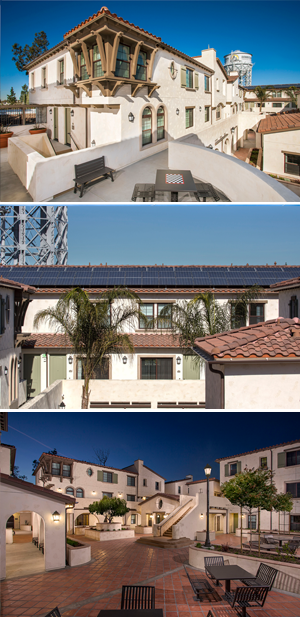TERRACES AT SANTIAGO HONORED FOR FINANCING STRUCTURE
BY THE NATIONAL ASSOCIATION OF LOCAL HOUSING FINANCE AGENCIES
ATLANTA, GA (March 14, 2014) – Terraces at Santiago, a workforce housing community built in Santa Ana by C&C Development Co., LLC and Orange Housing Development Corporation, was selected for top honors for its creative financing structure by the National Association of Local Housing Finance Agencies (NALHFA) at its annual conference.
The National Association of Local Housing Finance Agencies is the national association of professionals working to finance affordable housing in the broader community development context at the local level. As a non-profit association, NALHFA is an advocate before Congress and federal agencies on legislative and regulatory issues affecting affordable housing and provides technical assistance and educational opportunities to its members and the public. Members are city and county agencies, non-profits, and private firms, such as underwriters, consultants, financial advisers, bond counsels, and rating agencies, which help in producing housing from concept to completion.
For over 20 years, NALHFA has been recognizing the outstanding efforts of its member agencies and non-profit organizations through the annual awards program. The awards draw submissions from across the United States and in all categories of affordable housing development – single family, multifamily redevelopment, mixed-use, senior housing and many others.
“The Terraces at Santiago underscores the City of Santa Ana’s commitment to create quality workforce housing that is served by public transit to reduce traffic congestion, promote smart growth, and help improve our environment ,” said Santa Ana Councilwoman Michele Martinez, whose district surrounds Terraces at Santiago.
Developed on a less than one-acre site, Terraces at Santiago is the first apartment community to be built under the City of Santa Ana’s new Station District Transit Zoning Code. Its financing consists of a complex package of public and private funding . Financing sources included Bank of America, $7,336,710; HOME (Santa Ana), $2,500,000; Tax increment (Santa Ana), $710,437; and Neighborhood Stabilization Program (Santa Ana): $655,000. Permanent funding consists of California Community Reinvestment Corp. – Tax exempt permanent loan, $1,730,439; HOME (Santa Ana): $2,500,000; Tax increment (Santa Ana), $3,888,497; Neighborhood Stabilization Program (Santa Ana), $655,000; and Limited partner equity (National Equity Fund), $4,332,768.
The property is centered around the Santa Ana Regional Transportation Center (SARTC), a major hub of public transit within Orange County. Terraces is located in a mixed zoning area, with industrial users sharing property lines with the project to the North and the East. Appropriate site features were incorporated into the design to minimize the influence of the adjacent industrial uses.
“With the community’s affordable rents, lower income residents can live closer to where they work, thus decreasing the need to commute by private vehicle,” said Todd Cottle, principal of C&C Development. Its 36 apartments are affordable to families who earn between 30 percent and 50 percent of the area median income (AMI).
The workforce housing property consists of a mix of two-, three-, and five-bedroom units and is built over subterranean parking. In addition, Terraces at Santiago features gated pedestrian and auto access, a tot lot, onsite laundry facilities, community room, leasing office, shaded courtyards, and raised planter beds.
With a LEED Gold certification, Terraces at Santiago was designed with a focus on reducing energy and water usage, controlling waste management, and reducing operating and maintenance expenses. Terraces’ design aims to reduce energy usage by exceeding California’s energy efficiency regulation, Title 24 by at least 15 percent, incorporating high efficacy lighting, energy star appliances, and the use of a photovoltaic system to offset common area electricity usage. Water usage is conserved and reduced by the use of low flow fixtures and toilets, high efficacy irrigation system, and storm water is aggressively managed with onsite filtration.
Criteria for NALHFA award selection
The five selection criteria for the NALHFA Awards program are rigorous and demand the highest quality from submitting organizations.
• The first criterion is Extraordinary Benefit to the Community. The selection committee specifically examines projects to see if they meet the needs of low- and moderate-income segments of the community, achieve the organization’s community public purpose goals at low cost to the agency or non-profit and target particular neighborhood(s) for revitalization.
• The second criterion is Innovation. As we all know, affordable housing is a very challenging field and it demands creative models and strategies. Of key importance here is innovation in financing mechanisms, financing sources, partnerships, use of land or buildings and exceptional physical design components.
• Transferrability is the third criterion used in selecting award recipients. A central goal of the awards program is to promote new ways of developing affordable housing applicable in member communities that may differ by region, economic environment or other ways. Committee members specifically look for the extent to which the program or project could serve as a model or demonstration for other members, or could be replicated within other communities.
• The fourth criterion is Affordability. Specifically, what percentage of units have rents affordable to low- and moderate-income tenants. Also, to what degree does the program or project serve households at relatively low percentages of area median income. Finally, what is the tenure of affordability?
• The final criterion is Serving Needs of Special Groups, such as the physically or mentally disabled, elderly persons, single-family households, large families, the homeless, minorities or other groups targeted for assistance in the organization’s community.

